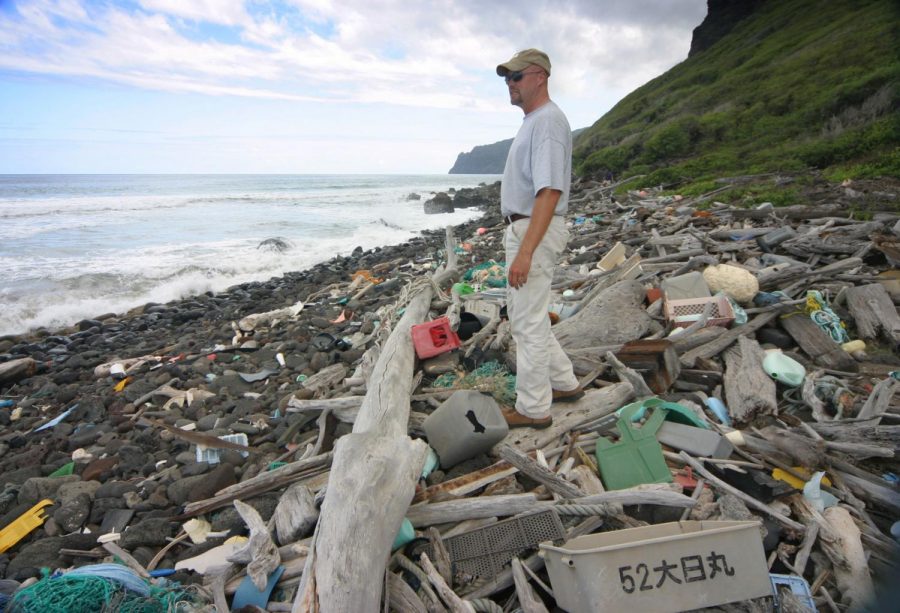Ocean Plastic Cleanup Project Finds Possible Solution
Opinion
Plastic litter is all around us nowadays – whether on beaches, the grass patches near roads, or out in the middle of the ocean. It’s too easy to Google and find countless photos of fish, birds, and other wildlife entangled in bags carelessly left on the sand or washed away into the water. Marine litter, the issue called into question by pictures like these, has become an increasingly concerning problem in recent years, as usage of plastic products in the world continues to rise and more trash ends up in places it doesn’t belong.
On his trip to Greece, 16 year old Dutch student Boyan Slat noticed that the amount of plastic he saw in the seawater was so immense that it even outnumbered the fish. Motivated by this holiday revelation, Slat began to develop an idea to deal with the intimidating task of cleaning up plastic in the oceans. He delivered a TED talk in 2012 about his plan, then later dropped out of his university to found the non-profit Ocean Cleanup campaign. The TED talk brought attention to the project and eventually provided funding from the general public, as well as wealthy industry leaders like Peter Thiel, a co-founder of PayPal. The Dutch government also got involved in providing investment to the startup. Using this money, the organization began to develop the machinery needed to carry out its ambitious plan.
After five years, the Ocean Cleanup is finally going to begin applying the technology that it has been testing to the plastic-infested waters. Their first target is in the Pacific Ocean, where the Great Garbage Patch holds a vortex of debris that spans across a massive area twice the size of the state of Texas. Just last Saturday, a two hour livestream broadcasted ships transporting the machinery and lowering it into the ocean.
How does this system actually work? The essential components are floating tubes that extend to 600 meters long, with a screen hanging from the floaters that reach down three meters into the water. Once the system is actually deployed, it will be propelled by the wind, waves, and water currents to passively travel along the surface of the ocean. Since the floater is moving because of the wind and waves, it will move faster than the plastic and trap the debris in the center of its giant “U”-like shape. Then, every couple of months, a ship will sail over to the system and gather the garbage that has been collected for transport back to the land to be processed and recycled.
The Ocean Cleanup has projected that half of the plastic floating around in the Garbage Patch could be retrieved in five years with this process. However, some are skeptical of whether or not the plan will actually be effective at gathering plastic. Scientists have pointed out that a significant amount of plastic sinks into the water instead of staying at the surface, which means that the floater wouldn’t be able to reach it. Others have stated that most plastic in the ocean is one centimeter or smaller, so the project’s trap would be useless because it would only be able to collect pieces that are two centimeters or bigger.
Several environmentalists are also questioning the side effects to this solution, such as damage to marine life, if it does work. A survey conducted of 15 ocean plastic experts showed that all of them believed or were worried the project could kill marine species nearby. A possibility remains that the giant system would become what is known as a fish aggregating device (FAD), attracting a large amount of marine animals and risking injury or death on them. Not only that, but the system itself was designed with polyethylene, a type of plastic, which could add to the very problem it is trying to solve.
If the system hurts marine life or doesn’t work, then it could contribute to the problems in our oceans. Not only could the system be difficult to efficiently remove, but since it may turn out to be one of the biggest offshore structures ever built, any negative impacts caused by the project would likely have a large magnitude.
However, the system has plenty of potential to become a leading solution to ocean plastic. Garbage remaining in the water can do damage to marine ecosystems for centuries before finally decomposing. At the very least, media coverage of the Ocean Cleanup project has already brought about awareness of the environmental implications of ocean plastic. If the system works as planned without any major side effects, then it would be extremely helpful with cleaning up the plastic already in our oceans.
That isn’t to say that the problem would be completely fixed, however, because the issue of plastic continuing to enter the oceans is still present and would also have to be addressed. But a success like this could represent a huge step in a good direction for environmentalists trying to limit the damage of plastic. Continued development of the technology with a clear idea of what needs to be fixed can help find the most optimal method to gather up mass amounts of floating plastic. Increased funding could be directed to projects like Ocean Cleanup to help develop more sustainable and effective systems that can both prevent plastic from entering oceans and clean up the garbage already there. Organizations and governments have and will continue to create campaigns to remove plastic before it enters the ocean, such as the annual Texas General Land Office Adopt-A-Beach cleanup. Ocean Cleanup could raise funding and participation for these types of programs as well. Even just finding out more about how the trash in the garbage patch behaves would go a long way. The project’s success would mark a huge milestone for Boyan Slat and his team, making all of the years they have spent testing and building worth it.
This is why, despite the uncertainty surrounding the project, the organization is carrying on. “We have to clean it up at some point in time and actually, I would say the sooner the better,” Boyan Slat said in a video posted on Facebook. “Truly, the only way to prove that we can rid the oceans of plastic is to actually go out there and deploy the world’s first ocean-cleaning system.” The nonprofit has given multiple statements besides this video both encouraging criticism for improved development and making adjustments based on the complaints they have received, such as replacing the original plan for a net trailing below the floater with a screen so that animals wouldn’t get entangled. They have also acknowledged that their system isn’t a perfect fix to the plastic problem, but minimizing what is already floating around in the trash patches is a critical part of the solution. “What is out there is out there,” Lonneke Holierhoek of Ocean Cleanup said. “If no one goes and gets it, it will stay out there.”
Over the next few weeks, the machinery will be transported to the specified location and set up accordingly. Then the cleanup will begin, with constant monitoring to watch out for mistakes or effects on the area around. Until the system begins to generate results, of course, there is no guarantee of what will happen. Regardless, given how close the Ocean Cleanup is to a large scale solution, this strategy may likely be the next crucial step forward in helping our world’s oceans.

This is my second year on the student press staff and first year as an opinion editor. Aside from writing stories and taking photos for press, I spend...







Daniel Chen • Sep 23, 2018 at 10:03 am
Nice article. Not sure why its filed under Opinions, seems like an honest news article to me.
Kamille Galloway • Sep 24, 2018 at 2:15 pm
The article isn’t completely objective, so that’s why it was filed under opinions. Thank you for your comment, though. 🙂